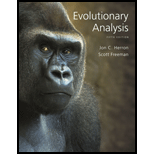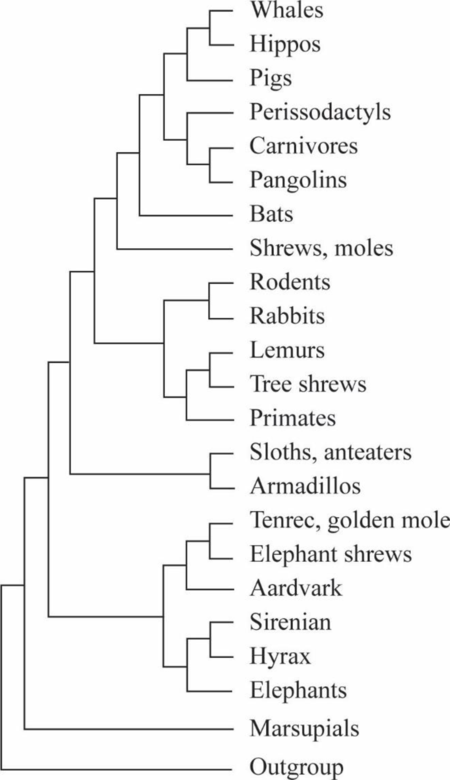
Concept explainers
According to the evolutionary tree in Figure 4.37, which is more closely related to rodents: shrews and moles, or primates? Explain how the tree shows this.

Figure 4.37 Phylogeny of the mammals From Murphy et al. (2001).
To determine: Whether shrews, moles, or primates are more closely related to rodents in the figure.
Introduction: Evolutionary tree, also known as phylogenetic tree, includes a branching diagram that shows the evolutionary relationships present among various species. An evolutionary tree helps to determine the similarities and differences present between various organisms.
Explanation of Solution
Pictorial representation: Fig.1 represents the evolutionary tree of mammals.

Fig.1: Phylogeny of mammals.
From the given phylogenetic tree, it is evident that primates are more closely related to each other than other organisms.
To determine: The reason why primates are more closely related to rodents.
Explanation of Solution
From the phylogenetic tree, the node descending between primates and rodents are more recent than any other groups. They both share a more recent common ancestor than primates and shrews or moles. Therefore, primates and rodents are more closely related to each other.
Want to see more full solutions like this?
Chapter 4 Solutions
Evolutionary Analysis (5th Edition)
Additional Science Textbook Solutions
Brock Biology of Microorganisms (15th Edition)
Campbell Biology in Focus
Campbell Essential Biology with Physiology (5th Edition)
Microbiology: Principles and Explorations
Laboratory Manual for Holes Human Anatomy & Physiology Fetal Pig Version
Laboratory Manual For Human Anatomy & Physiology
- The phylogenetic tree for 12 cat species (Felidae) reproduced at right was assembled from molecular sequence data. Which species is the domestic cats closest relative? Which clade is the sister taxon to tigers? Are bobcats more closely related to cougars or to ocelots? Source: From Warren E. Johnson et al. 2006. The late Miocene radiation of modern Felidae: A genetic assessment. Science 311:7377.arrow_forwardAnswer the following questions about this phylogenetic tree. What animal represents the out group in this tree and why? What is the derived characteristic of the birds? What is the shared characteristic of 3 to 6? Which number represents the common ancestor of Ostriches and Hawks?arrow_forwardBonobos and chimpanzees are sister groups. Humans, bonobos, and chimpanzees share a more recent ancestor than do humans and gorillas. Orangutans share an ancestor with all of these groups. Draw a cladogram that represents these relationships.arrow_forward
- Make a list of at least 10 morphological characters that you might use to generate a phylogenetic tree of the Caminalcules. Ignore the numbers found next to each Caminalcules- they do not represent who evolved first, second, etc. 2.Construct a phylogenetic tree of relationships (Hint: it may be easiest to cut out the critters so you can move them easily and then paste on them on a paper and draw the branches accordingly). 3.Identify at least 2 recent common ancestors and write at least three critical morphological changes along the branches on which they occurred. For example, did the claws appear (or disappear) as the different species evolved? 4.Take a picture of your phylogenetic tree and submit it with this document. ***Please note, this lab can be frustrating because you are “creating” the evolutionary story of how these critters evolved and who is more closely related to who (or not) along the way. There is no wrong answer since every student will focus on different…arrow_forwardAccording to the data, which two species in Table 3 are most closely related? Why do we think these two lineages diverged the shortest time ago? Which species is most closely related to humans? Which is most distantly related to humans To humans, alligators and crocodiles look very similar. However, which species difference in Table 3 comes closest to the difference between alligators and crocodiles? How can we explain this?arrow_forwardLook at the phylogenies below. Based only on the information provided here: 1. Are lizards more closely related to [Select] 2. Chimps and humans are a [Select] ✰ clade. Alternative Forms of Tree Diagrams Fishes Frogs Lizards Chimps Humans Vertical tree Fishes Frogs Lizards Chimps Humans -Diagonal treearrow_forward
- Flight evolved two times among the animals in this phylogenetic tree; once in birds, and once in bats (mammals). The branches on which flight evolved are marked. Please click where flight would have most likely evolved if it were actually a homologous character Targets placed: 0/1 You can place up to 1 targets Flight Undo Flight Delete selected Hagfish Lampreys Lobe-finned Fish Amphibians Turtles Lizards Snakes Crocodiles Birds Mammals Remove Allarrow_forwardHelp me pleasearrow_forwardFigure 8 represents possible lines of evolution of primates. Which of the following organisms from Figure 8 are most closely related?arrow_forward
- Hagfish Salamander Lizard Perch Mouse Chimp Pigeon Feathers Fur; mammary glands Claws or nails ungs Jaws Fig. 1. Cladogram on some vertebrates Related questions: 1. What is the synapomorhpy shared by the mouse and chimpanzee? Answer: 2. Specify the apomorphy of the pigeon. Answer: 3. Jaw is present to what taxa? Answer:arrow_forwardFor each statement about the trees shown below, indicate whether it is TRUE (1) or FALSE (2). These trees show that there are far more species of tetrapods (vertebrates with four limbs) than there are of bony fishes. Only tree 1 is accurate because it shows humans, the most complex species, at one end and fishes, the simplest lineage, at the other end. Humans and lizards are equally closely related to frogs according to both trees. The only difference between these two trees is that some of the internal nodes have been rotated. They show the same topology and therefore represent the same evolutionary relationships. The lineage represented by fishes has been evolving for a much longer time than the lineage represented by lizards.arrow_forwardThe tree below shows a proposed phylogeny of the three broadest mammal groups. monotremes marsupials eutherians Figure 1: Phylogenetic relationsbips between defrent ypes of mammals. a. Which group of mammals branched off the earliest? b. Which letter designates the common ancestor to monotremes and marsupials? c. Indicate where on the tree (short perpendicular line) each of the following characters arose. 1. long-lived placenta 4. internal gestation (rather than in egg) 2. body hair 5. long-term gestation 3. production of milk for young 6. live birth (rather than egg laying e. Which of the above characters are shared ancestral characters of eutherians? List all that apply.arrow_forward
 Biology: The Dynamic Science (MindTap Course List)BiologyISBN:9781305389892Author:Peter J. Russell, Paul E. Hertz, Beverly McMillanPublisher:Cengage Learning
Biology: The Dynamic Science (MindTap Course List)BiologyISBN:9781305389892Author:Peter J. Russell, Paul E. Hertz, Beverly McMillanPublisher:Cengage Learning
